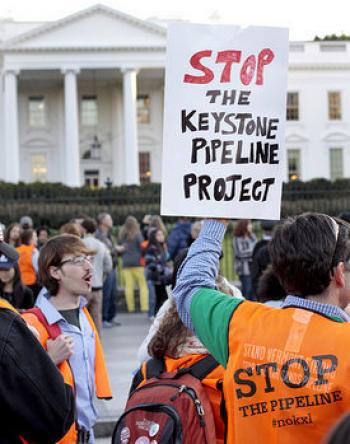On the final day of the Keystone XL public comment period for the State Department’s draft supplementary environmental impact statement (SEIS) of the KeystoneXL tar sands pipeline, the Environmental Protection Agency (EPA) issued a sharply critical assessment declaring the analysis “insufficient.”
The EPA’s objection is important, as the Washington Post explains, because it “not only provides opponents [of the pipeline] with political ammunition,” it could also “force President Obama to directly weigh in on the permitting decision” if the EPA raises similar objections to a possible ‘national interest determination’ by the State Department.
“As long as no other agency objects,” the Post continues, “State can issue a ruling on the pipeline on its own; if EPA challenges the national interest determination the State Department makes at the end of its review process, Obama himself would have to issue the final permit decision.”
In a letter to the State Department sent Monday, the EPA outlines detailed objections to the assessment of TransCanada’s proposed pipeline project. The letter specifically questions the “inevitability” of the tar sands extraction, increased carbon pollution, additional energy associated with production, the difficulty of cleaning spilled bitumen and the environmental sensitivity of the proposed route.
“These findings by EPA help confirm what we have been saying all along,” writes the NRDC’s Elizabeth Shope. “The environmental review by the State Department is inadequate … extracting, transporting and refining up to 830,000 barrels per day of dirty tar sands oil from Canada is not in our national interest.”
Analyzing the letter, Shope continues:
EPA rates the environmental impact statement with a 2 — meaning “insufficient” — and rates the environmental impact of Keystone XL as “EO” for “environmental objections.” EPA expresses serious concerns about the State Department’s markets analysis — which State uses to claim that there would be no significant effect on greenhouse gas emissions. EPA also writes that the differences in tar sands diluted bitumen spills and conventional oil spills should be more fully addressed, and that they are “concerned … that the DSEIS does not provide a detailed analysis of the Keystone Corridor Alternative routes.”
In 2011, the EPA expressed similar criticisms of the project.
Marking the end to the public comment period, grassroots environmental group 350.org celebrated the more than one million comments submitted to the U.S. State Department by opponents of the KXL pipeline.
“It’s going to take some time for State Department and the White House to go through a million comments, but when they do they’ll see a common thread: people from every part of the country in every walk of life think that this pipeline is bad for our land, water and climate,” said 350.org spokesperson Daniel Kessler.
“Families from Arkansas, Michigan, Nebraska and across the country have weighed-in in huge numbers urging President Obama and Secretary Kerry to reject Keystone XL,” added Nebraska landowner Randy Thompson.
“There is too much risk to trade away our health, our water and our land for a tar sands pipeline that benefits foreign oil companies. Momentum is building against the Keystone XL tar sands pipeline every single day.”
Lauren McCauley is a staff writer with Common Dreams, where this article was originally published. It is reprinted here with permission.
Photo: Emma Cassidy / Tar Sands Action



